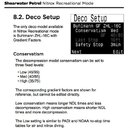- Messages
- 21,487
- Reaction score
- 21,742
- Location
- Philadelphia and Boynton Beach
- # of dives
- 2500 - 4999
Can someone direct me to where Shearwater says what its recreational GFs are?
In their rec manual, low conservatism https://www.shearwater.com/wp-content/uploads/2014/03/PetrelManual_Nitrox_Rec_Mode_DocRevA.pdf
---------- Post added September 29th, 2015 at 11:22 AM ----------
I hope this was not meant for me! My question was not about GFs, which I actually think I understand pretty well.
My question was about the alleged statement from Shearwater that their recreational mode is 45/95, and that it matches PADI/NOAA tables.
I understand it reasonably well also, looking for a more advanced reply
---------- Post added September 29th, 2015 at 11:23 AM ----------
Not if you ask 10 people who know what they're talking about.
Are you 1 of the 10, give me some useful information





